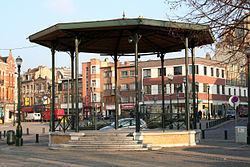Arrondissement Brussels Area codes 02 Local time Tuesday 7:39 PM | Region Brussels Postal codes 1190 Postal code 1190 | |
 | ||
Community Flemish CommunityFrench Community Weather 12°C, Wind SW at 10 km/h, 82% Humidity Points of interest Wiels, Duden Park, Stardust Park, Petit Train à Vapeur de Forest, Temple Of Tolerance | ||
Forest (French name, [fɔʁɛː]; Dutch: Vorst [vɔrst]) is one of the nineteen municipalities located in the Brussels-Capital Region of Belgium. It is bordered by Anderlecht, Ixelles, Uccle, Saint-Gilles and Drogenbos.
Contents
- Map of Forest Belgium
- Frankish origins and medieval period
- 17th century until today
- Sights
- Events and folklore
- Famous inhabitants
- Twin cities
- References
Map of Forest, Belgium
The town is commonly known for its concert hall (French: Forest National, Dutch: Vorst Nationaal). It also houses an important jail, an Audi factory and a railway depot that is home to the Belgian fleet of Eurostar train sets.
Frankish origins and medieval period
The first houses built in this forested area along the Geleysbeek, a tributary of the Zenne, date from the 7th century. The village's first church was dedicated to Saint Dionysius the Areopagite. The legend of Saint Alena, a young convert to Chalcedonian Christianity murdered by her father's troops for hearing mass at the church of Dionysius, also takes place in the 7th century. The chapel and cult of Saint Alena, however, date only from the 12th century. The saint's cenotaph, one of the rare examples of 12th-century sculpture in Belgium, can still be admired in the chapel today. The contiguous church of Saint Denis (Dionysius) was rebuilt in the Romanesque style at around the same time.
The abbots of Affligem, which had been the ecclesiastical owners of the parish since the bishop of Cambrai ceded it to them in 1105, decided to build a priory for women in Forest, Forest Abbey. The first abbess of the Forest priory was named in 1239. Also in the 13th century, the Romanesque church of Saint Denis was rebuilt in the newer Gothic style. The neighbouring abbatial church was rebuilt in the 15th century.
17th century until today
Thanks to its abbey, Forest prospered, especially during the reigns of Archdukes Albert and Isabella. On 26 March 1764, however, a devastating fire ruined some of the buildings and destroyed many of its artworks. Three decades later, in the years that followed the French Revolution, the religious community was disbanded, the nuns forced to flee, and the buildings sold. The Forest municipality bought the abbey in 1964 and proceeded to restore it to its previous glory.
